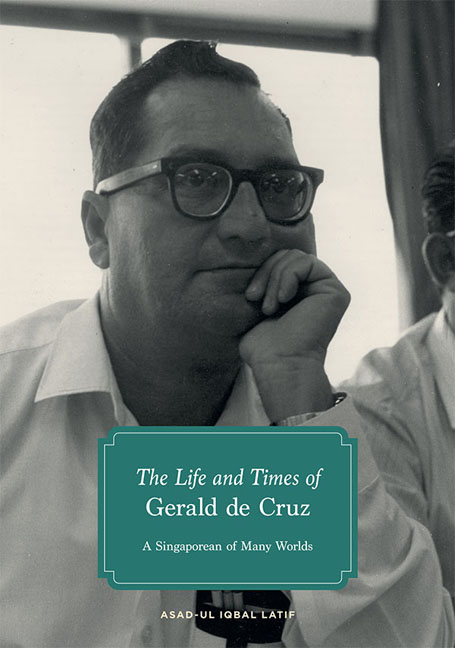Book contents
- Frontmatter
- Dedication
- Contents
- Preface
- Family Tree: Gerald Evelyn de Cruz
- 1 Don de Cruz de la Singapura
- 2 Childhood and Youth
- 3 The Japanese Occupation
- 4 The Communist Years
- 5 Going Abroad
- 6 The English Years
- 7 Return to Singapore
- 8 The Political Thinker
- 9 Friend of Labour
- 10 The Columnist
- 11 The Family Man
- Appendix
- Index
- About the Author
- Plate section
1 - Don de Cruz de la Singapura
Published online by Cambridge University Press: 19 May 2017
- Frontmatter
- Dedication
- Contents
- Preface
- Family Tree: Gerald Evelyn de Cruz
- 1 Don de Cruz de la Singapura
- 2 Childhood and Youth
- 3 The Japanese Occupation
- 4 The Communist Years
- 5 Going Abroad
- 6 The English Years
- 7 Return to Singapore
- 8 The Political Thinker
- 9 Friend of Labour
- 10 The Columnist
- 11 The Family Man
- Appendix
- Index
- About the Author
- Plate section
Summary
Gerald de Cruz wrote to his daughter, Judith, on 17 November 1975, saying that he envied her watching again the film, “Man of La Mancha”. Don Quixote's face is “as pasty as used canvas shoes; his walk almost as faltering as a drunk's his spear always getting in the way of gates or bags of flour; and his sword, if it can be called that, looking like the first cousin to prehistoric man's first attempt at a corkscrew”. Unlike Superman, who represents escape from the times and from reality, the “feeble, often ridiculous and frequently derided” figure of Don Quixote enchants people because they can recognize something of themselves in him. Born into what his creator, Miguel de Cervantes, calls a discourteous world, Don Quixote embodies the need for humans to meet the taunts of discourtesy. Prisoner of illusions himself, as every man is, the “sad and silly Knight” tilts at windmills. But why? Cervantes, wounded and captured in war and sold off into slavery before his family ransomed him at the cost of its financial ruin, experiences evil first-hand. However, he is interested in knowing, not why men die at the hands of evil, but why they have lived at all. They live, de Cruz avers, to confront the “distortions of reality which make it difficult to become human”. By proclaiming what it was like to be human in the charged sixteenth century, Don Quixote the Castilian not only became the hero of a great literary creation, but also immortal. “It does not matter a tinker's damn that we are weak”, de Cruz says of Don Quixote's sentimentality and delusions. “What matters is the direction in which our lives are pointed.” That is the lasting legacy of Cervantes’ canonical creation, El ingenioso hidalgo don Quijote de la Mancha — The Ingenious Gentleman Don Quixote of La Mancha.
The introspective intensity of de Cruz's engagement with Don Quixote suggests a degree of fellow feeling that could have come only from a shared experience of life preserved over four intervening centuries. Both were adventurous, astonishingly and sometimes dangerously so.
- Type
- Chapter
- Information
- The Life and Times of Gerald de CruzA Singaporean of Many Worlds, pp. 1 - 8Publisher: ISEAS–Yusof Ishak InstitutePrint publication year: 2015

